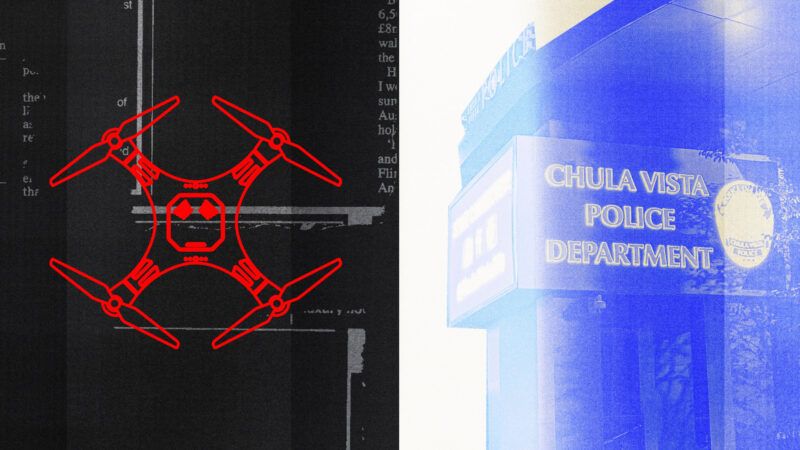Police Flew Drones Over One California City Nearly 20,000 Times in 6 Years
A WIRED investigation reveals the extent to which residents of Chula Vista are subjected to surveillance from the sky.

Last week, Reason reported on the rising trend of Colorado police departments increasingly using aerial drones as first responders to certain 911 calls.
A new investigation out this week reveals how such a system could work in practice, with startling implications for privacy and civil liberties.
In WIRED, Dhruv Mehrotra and Jesse Marx write about Chula Vista, a town in southern California roughly equidistant between San Diego and Tijuana. In 2018, the Chula Vista Police Department (CVPD) launched the Drone as First Responder (DFR) program, allowing 911 operators to deploy drones either in lieu of or in addition to uniformed officers—the first U.S. city to do so.
DFR "is not a replacement for officers, it's an enhancement," Police Chief Roxana Kennedy told KPBS at the time. In the program's first week, drones responded to 30 calls and led to three arrests, including a domestic violence case in which a man suspected of stabbing a woman fled back to a homeless encampment and a pursuing drone led police to his location. The program was initially limited to within one mile of the police station, but it expanded over time before receiving federal authorization to operate citywide in March 2021.
In the nearly six years since, as Mehrotra and Marx detail, CVPD drones have taken nearly 20,000 flights, "often dispatched for serious incidents like reports of armed individuals [but] also routinely deployed for minor issues such as shoplifting, vandalism, and loud music. Early in the Covid-19 pandemic, the city even used drones to broadcast public service announcements to homeless encampments."
WIRED examined "nearly 10,000 drone flight records from July 2021 to September 2023," encompassing "more than 22.3 million coordinates from flight paths," to assess CVPD's claim that drones are only dispatched in response to specific 911 calls or lawful searches and do not merely go roaming in search of suspicious activity.
"Drones were used in about 7 percent of the city's service requests," the authors found, including "nearly half of the incidents involving reports of armed individuals and about a quarter of those related to violent crime," plus mental health and domestic violence calls.
"The vast majority" of the 10,000 flight records analyzed "could be linked to corresponding 911 calls. But not all of them." In fact, about 10 percent "lacked a stated purpose and could not be connected to any relevant 911 call; for 498 flights, the department lists the reason as an 'unknown problem.'" Further, "nearly 400 [flights] didn't come within half a mile of where any call in the preceding half hour originated."
Even specifically sanctioned flights may be cause for concern: "Operators are trained to start recording with the drone's camera immediately, capturing video throughout the entire flight, from takeoff to landing," Mehrotra and Marx note. The cameras, "powerful enough to capture faces clearly and constantly recording while in flight, have amassed hundreds of hours of video footage of the city's residents," the vast majority of which the city has refused to release.
"On average, each drone flight passes above 13 census blocks and potentially exposes approximately 4,700 of the residents below to a drone's camera," the WIRED analysis found. And potential exposure did not fall equally: "Residents on a typical block in the working-class and largely immigrant west side of Chula Vista had drones in the skies above 10 times longer than a resident of a typical east-side block," Mehrotra wrote in WIRED's Politics Lab newsletter yesterday. West-side residents "alleged that police drones were following them personally, lingering unnecessarily in their backyards, or watching them during their most intimate moments," and others complained about the noise of drone rotors. (The CVPD claimed the disparity is due to the unequal number of 911 calls that each area receives; the WIRED analysis "confirm[ed] that this is largely the case.")
Interestingly, support for the drone program is also strongest among the lower-income Chula Vista residents most likely to be subjected to it. One Latino man—who lives in an apartment complex that CVPD drones have flown over more than 300 times since July 2021—told WIRED that the drones make him feel safer, especially after a stranger tried to steal his child and police deployed a drone to look for the suspect. This isn't unheard of: Polls show black Americans are significantly more afraid of the police than their white neighbors, yet they still want a strong, effective police presence in their neighborhoods.
Regardless, Chula Vista's drone program could be a concerning sign of where American policing is headed. Even apart from DFR, city residents have been subject to a shocking amount of surveillance in recent years: automated license plate readers, facial recognition software, and a partnership with Amazon for access to its Ring doorbell cameras. In December 2017, the CVPD partnered with a company to share its data with other law enforcement agencies, including federal agencies like Immigration and Customs Enforcement (ICE) and Customs and Border Protection (CBP).
As Colorado's example makes clear, police departments increasingly see DFR programs as a plausible alternative to traditional policing, in which an officer would be dispatched to the scene of an emergency. While that's certainly true, it would also expose everyday citizens to a shocking new world of state surveillance.


Show Comments (15)